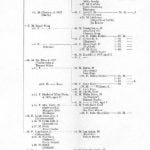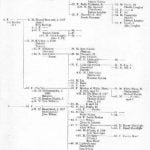ka’inchi, grandchild, w. sp.
| Gen. III, 3 > Gen. III, 24 | son’s son, w. sp. |
iba`, mother’s brother
| Gen. II, 57 > Gen. II, 30 | mother’s brother |
| Gen. III, 44 > Gen. III, 12 | mother’s brother |
| Gen. II, 57 > Gen. II, 34 | (iba`t’iti, little mother’s brother) mother’s brother |
| Gen. II, 63 > Gen. 11,48 | (iba`t’iti) mother’s brother |
| Gen. II, 59 > Gen. 11,12 | mother’s mother’s brother |
| Gen. I, 49 > Gen. I, 10 | parallel cousin removed. The mother of Gen. I, 49 called Gen. I, 10, brother. |
| Gen. I, 42 > Gen. I, 17 | father’s sister’s husband |
| Gen. I, 42 > Gen. I, 19 | father’s sister’s husband |
aha’i’, father’s sister
| Gen. I, 42 > Gen. I, 15 | father’s sister |
| Gen. II, 30 > Gen. II, 15 | father’s sister |
| Gen. III, 37 > Gen. III, 14 | (ahaitete, father’s little sister) father’s sister |
| Gen. I, 51 > Gen. I, 28 | (aha’i’t’iti, father’s little sister) father’s sister; also Ina’t’iti parallel |
| Gen. I, 42 > Gen. I, 21 | cousin removed. The father of Gen. I, 42 called Gen. I, 21, sister. |
ine”, older brother of a male, parallel cousin
| Gen. II, 12 > Gen. I, 8 | older brother |
| Gen. I, 42 > Gen. I, 37 | older half brother |
| Gen. III, 12 > Gen. III, 6 | older half brother |
| Gen. I, 42 > Gen. I, 30 | father’s brother’s son. Gen. I, 30 is actually senior to Gen. I, 42; but Gen. I, 42 (White Moon) stated that he called Gen. I, 30, Haninshu’wi, older brother not because Haninshu’wi was his senior, but because Haninshu’wi’s father was senior to White Moon’s father. This is borne out by: |
| Gen. I, 42 > Gen. 1,34 | father’s brother’s son, actually younger than Gen. I, 42 father’s |
| Gen. III, 33 > Gen. III, 24 | brother’s son (inehtete) |
| Gen. II, 51, 54 > Gen. II, 50 Gen. I, 61 > (in theory) | mothers sister’s son |
| Gen. I, 55 | father’s father’s brother’s son’s son |
| Gen. II, 59>Gen. II, 57, 58 | (hanint’iti) mother’s mother’s brother’s daughter’s son |
| Gen. I, 42 > Gen. I, 51 | (hanint’iti) father’s sister’s son’s daughter. This is a theoretical application, and given dubiously, as one might expect in view of the double cross-cousinship involved. In practice the personal name is used. |
| Gen. III, 12 > Gen. III, 25 | half brother’s son’s wife |
The term may be used in a general sense, thus Chu”uu (Gen. II, 15) calls Inkinishit’iti, Little white-man, hanin inkinish, white-man child.
netsi’oiha, my spouse, desc.
| Gen. II, 15 > Gen. II, 18 | husband |
| Gen. II, 15 > Gen. II, 17 | deceased husband |
| Gen. II, 18 > Gen. II, 15 | wife |
iba’kin, father-in-law, son-in-law, desc.
This term may be used by male or female; it is applied to males only. Between males it is a reciprocal term.
| Gen. I, 37 > Gen. I, 10 | father-in-law, w. sp. |
| Gen. I, 31 > Gen. I, 7 | father-in-law, w. sp. |
| Gen. III, 38 > Gen. III, 12 | father-in-law, w. sp. |
| Gen. I, 17> Gen. I, 7 | father-in-law, m. sp. |
| Gen. I, 9 > Gen. I, 17 | son-in-law, w. sp. |
| Gen. II, 15 > Gen. I, 38 | son-in-law, w. sp. |
| Gen. I, 7 > Gen. I, 1’7 | son-in-law, m. sp. |
chu’u’nu, mother-in-law, daughter-in-law, desc.
This term may be used by male or female; it is applied to women only. Between females it is a reciprocal term.
| Gen. I, 45 > Gen. I, 14 | mother-in-law, w. sp. |
| Gen. I, 17 > Gen. I, 9 | mother-in-law, m. sp. |
| Gen. I, 9>Gen. I, 28 | step-daughter-in-law, w. sp. |
| Gen. I, 7 > Gen. I, 31 | daughter-in-law, m. sp.; in address, hanin |
| Gen. I, 10>Gen. I, 37 | daughter-in-law, m. sp. |
| Gen. III, 12 > Gen. III, 38 | daughter-in-law, m. sp. (chu’uno) |
| Gen. I, 42 > Gen. I, 9 | wife of father’s brother |
| Gen. I, 45 > Gen. I, 9 | wife of husband’s father’s brother |
| Gen. I, 9>Gen. I, 45 | wife of husband’s brother’s son |
| Gen. II, 59>Gen. II, | 10 wife of mother’s mother’s brother |
ikwi, affinity term applied to women of another generation than that of speaker, desc.
From the following application of this term it appears to be equivalent to chu’u’nu; but my informant denied this, quite evidently feeling a distinction without being able to point it out either in theory or in application.
| Gen. I, 45 > Gen. I, 14 | mother-in-law, w. sp. |
| Gen. I, 17 > Gen. I, 9 | mother-in-law, m. sp. |
| Gen. I, 42 > Gen. I, 9 | wife of father’s brother |
| Gen. II, 59>Gen. II, 14 | wife of mother’s mother’s brother |
| Gen. I, 7 > Gen. I, 31 | daughter-in-law, m. sp. |
da’hai’, sister-in-law, brother-in-law, voc. And desc.
This term is reciprocal.
| Gen. I, 17 >Gen. I, 30 | wife’s brother |
| Gen. I, 30>Gen. I, 17 | husband of sister, m. sp. |
| Gen. II, 43 >Gen. II, 40 | husband’s brother |
| Gen. I, 45 >Gen. I, 42 | husband’s half brother |
| Gen. II, 9>Gen. III, 12 | husband’s half brother, (dahaiye) |
| Gen. II, 40>Gen. II, 43 | wife of brother, m. sp. |
| Gen. 42 >Gen. I, 45 | wife of half brother, m. sp. |
| Gen. III. 12 >Gen. III, 9 | wife of half brother, m. sp. (dahaiye) |
| Gen. I, 31 >Gen. 1 33 | husband’s sister wife of brother, w. sp. |
| Gen. I, 24>Gen. I, 13 | wife’s sister. She is also his mother’s brother’s wife |
| Gen. I, 14>Gen. I, 24 | sister’s husband, w. sp. |
| Gen. I, 31 >Gen. I, 42 | husband’s father’s brother’s son |
| Gen- I, 42 >Gen. I, 31 | wife of father’s brother’s son |
| Gen. I, 23 >Gen. I, 10 | wife’s parallel cousin |
Expressed in the nomenclature is the forked merging kinship system, collateral kin being merged with lineal and paternal and maternal collaterals in the parent generation being distinguished, through separate terms for mother’s brother and father’s sister. 1 Father’s brother is classed with father, and mother’s sister with mother. In the grandparent veneration there is no distinction between paternal and maternal kin. Parallel cousins offspring of two brothers or of two sisters are referred to by sibling terminology; but for cross-cousins, offspring of a sister and a brother, there is a distinctive term.
Citations:
- In the other Caddoan kinship terminologies as recorded by Morgan there is no separate term for father’s sister who is called mother (Morgan, Table II).[↩]



